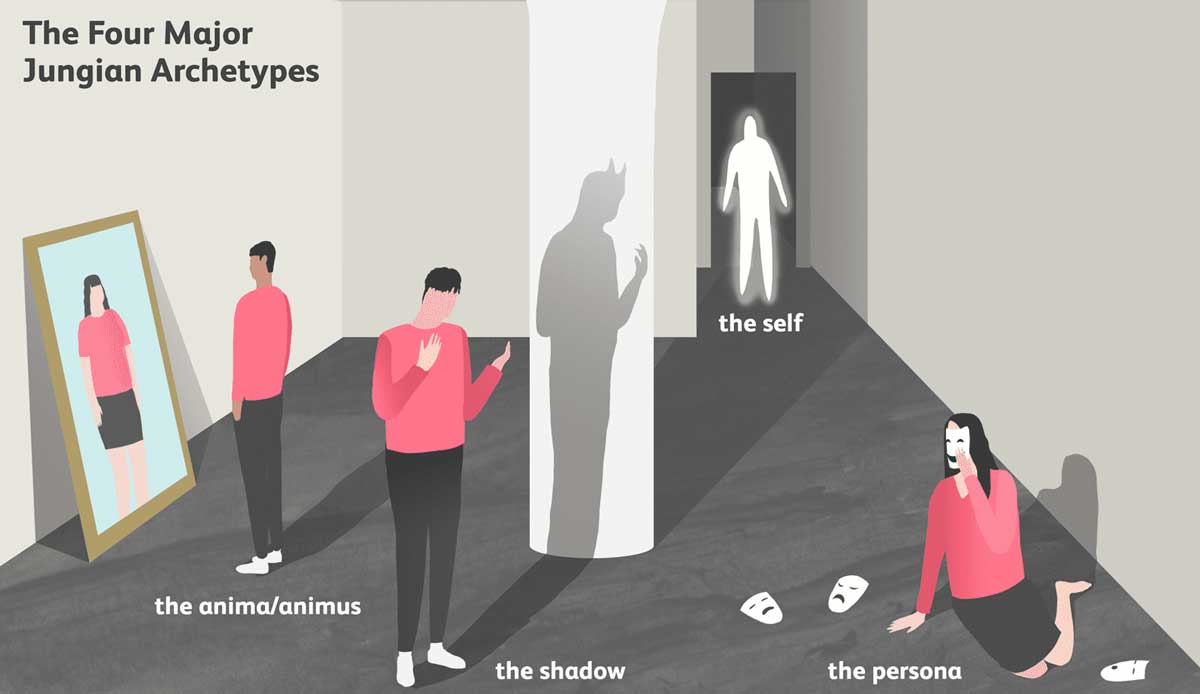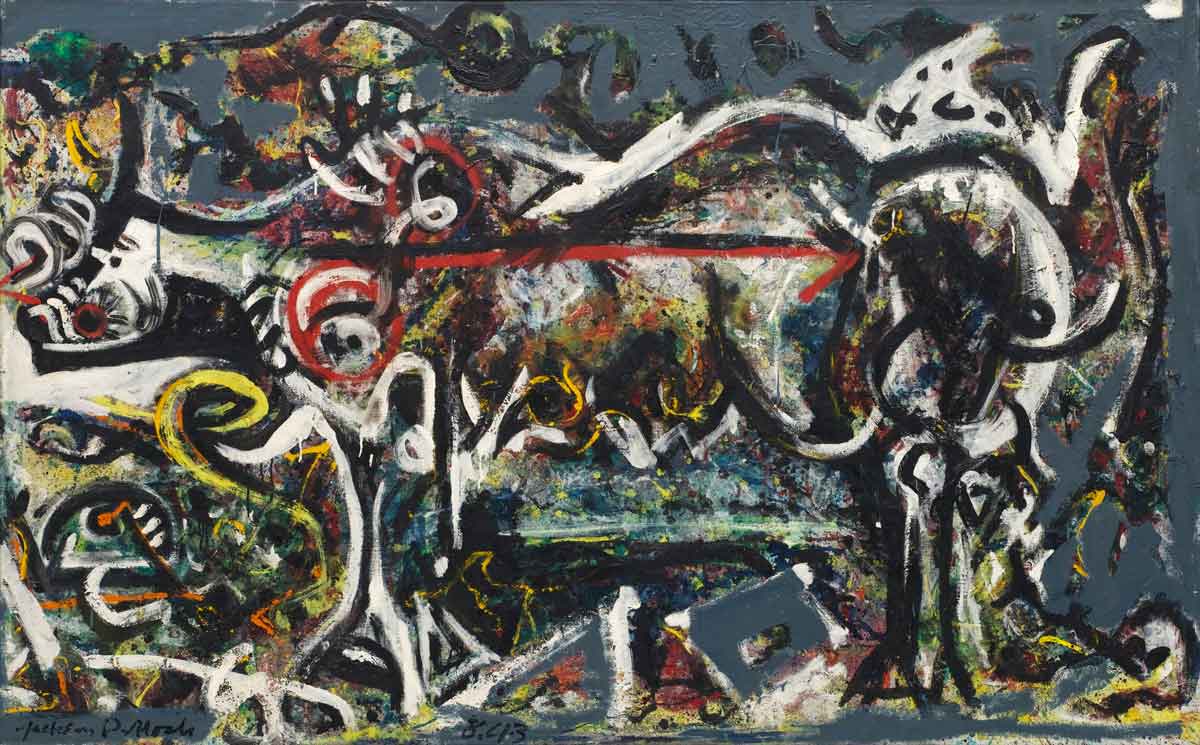
Psychologists like Sigmund Freud and Carl Gustav Jung impacted 20th-century art movements, especially Surrealism and Abstract Expressionism. Jackson Pollock is one of the most famous Abstract Expressionists, but he is also an artist who showed a great deal of interest in Carl Jung’s work. Read on to learn more about the connections between Pollock’s paintings and Jung’s theories.
Who Was Jackson Pollock?

Jackson Pollock (1912 –1956) was an American artist and a leading painter of the movement called Abstract Expressionism. Abstract Expressionists were working with free-associative gestures in painting, often defined as action painting. Pollock is especially famous for his drip technique. For this, the American artist used large canvases that he placed on the floor. He would then walk around the canvas and freely pour paint on it. Pollock was also one of the first globally recognized American modern artists. Until the 20th century, the center of the artistic movements was Europe. Pollock was among the first artists who helped transfer the artistic center to the United States.
Who Was Carl Jung?

Carl Jung (1875 –1961) was a Swiss psychologist. Just like Freud, Jung was also very interested in the human unconscious. According to Jung, the psyche features different levels of consciousness: the conscious, unconscious, and collective unconscious. The collective unconscious is a set of accumulated experiences lived by our ancestors and past generations. Jung believed that this is where artistic creativity originated from.

Get the latest articles delivered to your inbox
Sign up to our Free Weekly Newsletter
Archetypes represent another concept important for understanding Jung. According to Jung, archetypes come from the collective unconscious. Although there are many of them, there are four common ones that exist in every human being, regardless of age or ethnic background. The first one is the persona or the mask that we put on when we interact with other people. This shows the ways in which we want to be perceived by others. The second archetype is the anima, the part of us that is hidden from the public, and according to Jung reflects the feminine side of us. Jungian psychologists later added the term animus which can be defined as one’s masculine side.
The third archetype is the shadow, representing the darker side of a person. Jung believed that artistic inspiration came from shadow. The final and probably most important archetype is the self. When the self is developed, one can connect to the conscious and the unconscious. The developed self means that a person has a formed personality.

Jung thought that these archetypes could be found in different symbolic images.
In Pollock’s painting, we can find many symbols that can be related to Jungian theory. Some of these are the masks, the contrast of the opposites (light/dark, female/male, or anima/animus, etc.). Pollock was also inspired by the Jungian interest in the collective unconscious. He was influenced by mythology and both American and Mexican native cultures.
How Did Pollock Get into Jungian Theory?

Pollock probably got introduced to Jungian theories when he was very young. He was working as a janitor in a school in New York when he met Helen Marot, a teacher who introduced him to Jung’s psychology and informed him about Jung’s latest texts and translations. Pollock was struggling with alcoholism, so he decided to attend psychotherapy. He started attending sessions with Jungian psychologist Joseph Henderson in 1939.
Pollock wasn’t very talkative during these meetings, so his therapist agreed that he could produce paintings as a basis for psychoanalysis. During the two years that they were meeting for therapy, Pollock produced 83 images. We can see these images in Claude Cernuschi’s book Jackson Pollock: The Psychoanalytic Drawings. In 1940, Henderson moved to San Francisco and therefore stopped his sessions with Pollock. However, the artist continued his therapy sessions with other Jungian psychologists.
We, therefore, know that Pollock read Jung’s work, attended Jungian psychotherapy, and produced Jung-inspired images. He was greatly inspired by mythology, symbols, and the unconscious way of painting. Let’s explore Pollock’s works and see how we can interpret his paintings through Carl Jung’s theories.
Early Works

At the beginning of his artistic career, Jackson Pollock was very inspired by myths. His paintings were colorful and reminiscent of native American and Mexican art.
When Joseph Henderson moved from New York and stopped working with Pollock, the artist decided to give him a painting as a gift. The painting was called The Crucifixion. In the work, shapes are made out of four colors: yellow, blue, green, and red. These colors correspond with Jung’s theory about four basic human functions, as proposed in his Psychological Types. These are intuition, thinking, sensation, and emotion. To each of these functions, Jung attributed a color. Intuition is yellow because it shines and radiates. Thinking is blue, while sensation is green because it is connected to the earth and perceiving reality. Finally, emotion is red, because it is connected to blood, fire, passion, and love.

Another interesting painting from Pollock’s early period is Bird. In this colorful composition, there is a one-eyed bird with its wings spread. The eye could be interpreted as the third eye, a symbol of self-analysis and Pollock’s introspection. Many psychologists tend to analyze this painting as Pollock’s desire to complete his individuation, that is, to complete his personality.

Moon Woman Cuts the Circle is one of Pollock’s paintings in which the moon is the main protagonist. It is generally considered that the moon represents women in Pollock’s work. Elizabeth L. Langhorne even wrote that Pollock was suffering from a bad mother complex. The bad relationship with his mother Stella influenced him both as a person and a painter. For the rest of his life, Pollock often had difficulties in relationships with women.

Another painting that deals with the same subject is The She-wolf. In this chaotic composition, which approaches abstraction, Pollock depicted a she-wolf. He could have found the inspiration for this subject in Jung’s book Psychology of the Unconscious where the author describes the psychosis of a possessive mother in delirium writing about her: on all fours, howling like a wolf… She had herself become the symbol of the all-devouring mother.

Pollock often painted opposites. This can be noticed in the painting called Male and Female. Once again the representation of the opposites is regarded as a desire for individuation, which can be achieved only when the opposites are brought together. In this painting, we can see two figures. One is colorful and curvy, while the other one seems rigid. This can be understood as the exploration of Jungian concepts of the anima and animus. The anima and animus, the female and male, are getting united in this painting.
Later Works

In 1945, Pollock and his wife Lee Krasner moved to a farmhouse on Long Island. Two years after settling in their new home, Pollock started making his first drip paintings. There was a significant change in Pollock’s style after the move. However, the paintings were not the only thing that changed. Pollock also stopped drinking for many years.
The artist once said that painting was self-discovery and that every good artist paints what he is. During this time, Pollock painted in order to self-discover, implementing automatism. Automatism in art meant that the artist created without conscious thoughts. Therefore, he created things using the unconscious mind. Pollock would place a large canvas on the floor and then pour the paint over it. All his works from this period are completely abstract, therefore, we can not recognize any particular motifs or symbols. However, the technique he implemented in his artistic process and his desire to connect with the unconscious can still be connected to a Jungian influence.

One of his works from his late period is called Mural. This is the largest painting Pollock ever created. It can be regarded as a form of liberation, as a breaking point in his artistic technique.

During this period Pollock produced numerous artworks, mostly through his drip technique. Some of his most famous works from this era include Eyes in the heat (1946), Galaxy (1947), and Alchemy (1947).
The Last Works of Jackson Pollock
In 1951 Hans Namuth released a short film about Pollock in which he documented his painting process. Soon after, Pollock suffered a breakdown. He suddenly went back to alcoholism. He stopped making abstract works of art and returned to symbols seen in his early works. However, the color was now absent. His very last works consisted of black paint on white canvases.

On the left side of a work titled Number 7 we see different vertical lines, while on the right side, we see a woman’s body. It is possible that in this painting Pollock returned to fears related to his relationship with his mother.

Portrait and a Dream can be read as a self-portrait. The left side of the canvas consists of an abstract portrait made out of poured black paint. On the right side, we see a colorful abstract face. When looking at this portrait we can once more notice the opposites appear. There is a contrast between dark and light. Looking at Jung’s archetypes, we can say that the left portrait is the representation of the shadow, one’s darker side, while the right portrait represents the self or the completed individual.
In 1956, Pollock stopped painting completely. A few months later he died in a single-car crash while driving under the influence of alcohol. A few months before his death, he said: We’re all of us influenced by Freud, I guess. I’ve been a Jungian for a long time.








